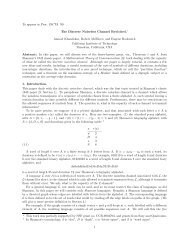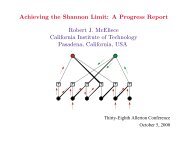Viterbi's Impact on the Exploration of the Solar System
Viterbi's Impact on the Exploration of the Solar System
Viterbi's Impact on the Exploration of the Solar System
You also want an ePaper? Increase the reach of your titles
YUMPU automatically turns print PDFs into web optimized ePapers that Google loves.
have made use <strong>of</strong> <strong>the</strong> fact that go(p) is c<strong>on</strong>cave.<br />
property b) we have lim,,,, &(p)/p =<br />
. Thus we obtain<br />
1<br />
<strong>on</strong>ent E,(R) in <strong>the</strong> lower bound is a positive<br />
decreasing c<strong>on</strong>tinuous functi<strong>on</strong> <strong>of</strong> R for all<br />
ical c<strong>on</strong>structi<strong>on</strong> <strong>of</strong> <strong>the</strong> exp<strong>on</strong>ent-rate curve<br />
t <strong>of</strong> <strong>the</strong> functi<strong>on</strong> E,,(p) is shown in Fig. 4. We<br />
er c<strong>on</strong>siderati<strong>on</strong> <strong>of</strong> <strong>the</strong> properties <strong>of</strong> (16)<br />
an upper bound is obtained.<br />
r lower bound <strong>on</strong> error probability for low<br />
tained by replacing <strong>the</strong> sphere packing bound<br />
<strong>the</strong> tighter lower bound for low rates recently<br />
by Shann<strong>on</strong>, Gallager, and Berlekamp.17’ For<br />
(6) is replaced by<br />
AFOSR-700-65.<br />
I -lim [P 111 F T p(4pb’)<br />
m<br />
&P(Y I 4P(Y I ~‘>Yl~ = &(i3. (17b)<br />
Y<br />
ht line <strong>of</strong> (17a) is tangent to <strong>the</strong> curve <strong>of</strong> (6)<br />
+ 1)/p@;(p). Repeating <strong>the</strong> minimizati<strong>on</strong> with<br />
CL we find<br />
E&l = min [(P + l)Ez - &RI<br />
*<br />
have<br />
2<br />
0 < R < Elbl<br />
=E,, -MC.<br />
rates a tighter lower bound than that <strong>of</strong><br />
1 is:<br />
PX > & i -NE&) + o(N)lJ<br />
where<br />
(b) p’l<br />
Fig. 4. Graphical c<strong>on</strong>structi<strong>on</strong> <strong>of</strong> EL(R) from I%(P).<br />
Error Bounds for C<strong>on</strong>voluti<strong>on</strong>al Codes<br />
and an Asymptotically Optimum<br />
Decoding Algorithm<br />
p’ is <strong>the</strong> soluti<strong>on</strong> ANDREW to J. <strong>the</strong> VITERBI, equati<strong>on</strong> SENIOR E,,(c) MEMBER, = E,, IEEE and E, is<br />
given by (17b).<br />
Ahstraci-The probability <strong>of</strong> error in decoding an optimal c<strong>on</strong>voluti<strong>on</strong>al<br />
code transmitted over a memoryless channel is bounded<br />
from above and below as a functi<strong>on</strong> <strong>of</strong> <strong>the</strong> c<strong>on</strong>straint length <strong>of</strong> <strong>the</strong><br />
code. For all but pathological channels <strong>the</strong> bounds are asymptotically<br />
(exp<strong>on</strong>entially) tight for rates above &, <strong>the</strong> computati<strong>on</strong>al cut<strong>of</strong>f<br />
rate <strong>of</strong> sequential decoding. As a functi<strong>on</strong> <strong>of</strong> c<strong>on</strong>straint length <strong>the</strong><br />
performance <strong>of</strong> optimal c<strong>on</strong>voluti<strong>on</strong>al codes is shown to be superior<br />
to that <strong>of</strong> block codes <strong>of</strong> <strong>the</strong> same length, <strong>the</strong> relative improvement<br />
IV. A PROBABILISTIC NONSEQTJENTIAL DECODING<br />
ALGORITHM<br />
We now describe a new probabilistic n<strong>on</strong>sequential<br />
decoding algorithm which, as we shall show in <strong>the</strong><br />
next secti<strong>on</strong>, is asymptotically s optimum for rates R ><br />
R, = E,(l). The algorithm decodes an L-branch tree<br />
by performing L repetiti<strong>on</strong>s <strong>of</strong> <strong>on</strong>e basic step. We adopt<br />
<strong>the</strong> c<strong>on</strong>venti<strong>on</strong> <strong>of</strong> denoting each branch <strong>of</strong> a given path<br />
by its data symbol ai, an element <strong>of</strong> GE(q). Also, although<br />
GE(q) is isomorphic to <strong>the</strong> integers modulo (r <strong>on</strong>ly when<br />
Q is a prime, for <strong>the</strong> sake <strong>of</strong> compact notati<strong>on</strong>, we shall<br />
use <strong>the</strong> integer r to denote <strong>the</strong> rth element <strong>of</strong> <strong>the</strong> field.<br />
In Step 1 <strong>the</strong> decoder c<strong>on</strong>siders all qK paths for <strong>the</strong><br />
first K branches (where K is <strong>the</strong> branch c<strong>on</strong>straint length<br />
<strong>of</strong> <strong>the</strong> code) and computes all qK likelihood functi<strong>on</strong>s<br />
n;?I1 p(y, 1 ai). The decoder <strong>the</strong>n compares <strong>the</strong> likelihood<br />
functi<strong>on</strong> for <strong>the</strong> q paths:<br />
Manuscript received May 20, 1966; revised November 14, 1966.<br />
The research for this work was sp<strong>on</strong>sored by Applied Ma<strong>the</strong>matics<br />
Divisi<strong>on</strong>, Office <strong>of</strong> Aerospace Research, U. S. Air Force, Grant<br />
The author is with <strong>the</strong> Department <strong>of</strong> Engineering, University <strong>of</strong><br />
California, Los Angeles, Calif.<br />
(0, az, a, . . * 4,<br />
0, a2, a3, ... ad,<br />
. . . . . . . . . . . . . . . . . .<br />
(a - 1, az, a3, . . . ad<br />
Increasing with rate. The upper bound is obtained for a specific<br />
probabilistic n<strong>on</strong>sequential decoding algorithm which is shown to be<br />
asymptotically optimum for rates above Ra and whose performance<br />
bears certain similarities to that <strong>of</strong> sequential decoding algorithms.<br />
I. SUMMARY OF RESULTS<br />
INCE Elias”] first proposed <strong>the</strong> use <strong>of</strong> c<strong>on</strong>voluti<strong>on</strong>al<br />
(tree) codes for <strong>the</strong> discrete memoryless channel,<br />
it has been c<strong>on</strong>jectured that <strong>the</strong> performance <strong>of</strong><br />
this class <strong>of</strong> codes is potentially superior to that <strong>of</strong> block<br />
codes <strong>of</strong> <strong>the</strong> same length. The first quantitative verificati<strong>on</strong><br />
<strong>of</strong> this c<strong>on</strong>jecture was due to Yudkinr2’ who obtained<br />
for each <strong>of</strong> <strong>the</strong> qK-l possible vectors (az, a3 . . . ar;).<br />
It thus performs qIcel comparis<strong>on</strong>s each am<strong>on</strong>g q path<br />
likelihood functi<strong>on</strong>s. Let <strong>the</strong> path corresp<strong>on</strong>ding to <strong>the</strong><br />
greatest likelihood functi<strong>on</strong> in each comparis<strong>on</strong> be denoted<br />
<strong>the</strong> survivor. Only <strong>the</strong> q”-’ survivors <strong>of</strong> as many com-<br />
paris<strong>on</strong>s are preserved for fur<strong>the</strong>r c<strong>on</strong>siderati<strong>on</strong>; <strong>the</strong><br />
remaining paths are discarded. Am<strong>on</strong>g <strong>the</strong> qK-’ survivors






